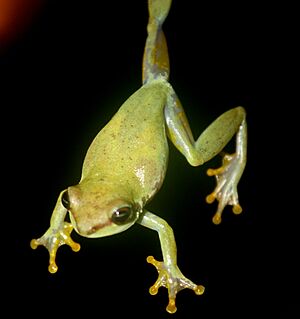Hyperolius fusciventris facts for kids
Quick facts for kids Hyperolius fusciventris |
|
|---|---|
 |
|
| Conservation status | |
| Scientific classification |
Hyperolius fusciventris is a type of frog that belongs to the family Hyperoliidae. You might know it by its common name, the lime reed frog. This little frog lives in parts of West Africa and Middle Africa, from Sierra Leone all the way to western Cameroon.
Contents
Where Does It Live?
The lime reed frog can be found in many countries across West and Middle Africa. Starting from the west, you can find it in Sierra Leone, Guinea, Liberia, Ivory Coast, Ghana, Togo, Benin, Nigeria, and Cameroon. There's also a possible sighting in Guinea-Bissau, but scientists are still checking to make sure.
Different Types of Lime Reed Frogs
Scientists sometimes divide animal species into smaller groups called subspecies. These are like different versions of the same animal that live in different places or have small differences. The lime reed frog has three named subspecies and one unnamed group:
- Hyperolius fusciventris fusciventris — Found from Sierra Leone to the western part of Ivory Coast.
- Hyperolius fusciventris lamtoensis — Lives in Ivory Coast.
- Hyperolius fusciventris burtoni — Found from Ghana to Nigeria.
- Hyperolius fusciventris ssp. — This unnamed group lives in Cameroon.
Scientists are still studying these groups. They might even decide that some of these subspecies are actually completely separate species!
What Does It Look Like?
The lime reed frog is a fairly small frog. Male frogs are about 18–25 mm (0.71–0.98 in) long from their snout to their rear end. Female frogs are a bit bigger, measuring about 23–28 mm (0.91–1.10 in). Their pupils (the dark part in the middle of their eyes) are shaped like a horizontal line.
Color Changes
These frogs can change their colors! They have two main color phases:
- Phase "J" (Juvenile): All young frogs and many adult males are light green. They have clear, light stripes along their sides and sometimes a dark line down their back.
- Phase "F" (Adult): All female frogs, and some males, change into this phase before they start breeding. In this phase, their back (called the dorsum) is a solid green color.
Frog Calls
Male lime reed frogs make a special sound to attract females. Their call has two parts: first, a "creak," followed by a few quick "clicks."
Habitat and Life Cycle
Lime reed frogs like to live in clearings within forests. They can also be found in forests that have grown back after being cut down, or in areas where forests have been heavily changed by farming.
Where They Lay Eggs
These frogs lay their eggs in small, temporary pools of water or in marshy areas. What's interesting is that they don't lay their eggs directly in the water. Instead, they place their eggs on leaves that are hanging over the water.
Conservation Status
The lime reed frog is generally a very common species. However, one of its subspecies, Hyperolius f. lamtoensis, is facing some challenges. Its home is shrinking because of farming, logging, and new human settlements.
Luckily, the other subspecies are more adaptable. This means they can live in different kinds of environments and are not currently facing major threats. The lime reed frog can be found in several protected areas, like the Taï National Park in Ivory Coast, and the Ankasa Conservation Area and Kakum National Park in Ghana. These parks help protect the frogs and their homes.


